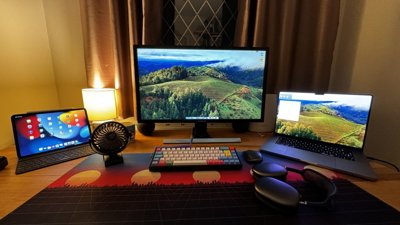An article over at Computerworld notes that Parallels has sold over 1 million of its Parallels Desktop offering since 2006, while VMware, which only recently launched its Fusion product, says it sold 250,000 copies in the first five months.
Both solutions fetch $80, and therefore VMWare's come-from-behind effort has landed the company in a "neck and neck" race with Parallels in terms of shipments and unit sales, according to NPD software analyst Michael Redmond. Based on his firm's analytical data, he believes the Mac virtualization software market will grow into a $15 million - $20 million business this year.
"Clearly, the performance gains of [Macs] moving to Intel processors are encouraging more users to experiment with virtualization," Redmond said.
Earlier this week, the two Mac virtualization software makers intensified their head-to-head bout with product announcements and buying incentives.
VMWare announced version 2.0 of Fusion, a free download for version 1.x owners — $76 for new owners — that delivers experimental support for up to four CPUs per virtual machine, improved gaming graphics via DirectX 9.0's Shader Model, and virtualization support for Mac OS X Server.
Parallels, hard at work on version 4.0 of its Desktop client, countered with two promotional deals on its existing version. The first offers a free $25 iTunes gift card with the purchase of Parallels Desktop 3.0. A second offers the software to students for $49.99 through the end of the month.
Unlike Apple's Boot Camp technology that comes built into Mac OS X 10.5 Leopard, both Parallels Desktop and Fusion allow users to run Mac and Windows operating systems simultaneously, without the need for a restart.
 Katie Marsal
Katie Marsal

 Mike Wuerthele and Malcolm Owen
Mike Wuerthele and Malcolm Owen
 Amber Neely
Amber Neely
 Malcolm Owen
Malcolm Owen
 William Gallagher
William Gallagher

 Christine McKee
Christine McKee
 Oliver Haslam
Oliver Haslam
 Wesley Hilliard
Wesley Hilliard









47 Comments
I was a shareholder in VMW when I bought my new iMac. I downloaded the virtualization software but could not get it to work after numerous attempts.
Then I tried Parallel's, and it worked on the first try.
I sold my VMW shares and then the stock fell more than 50%. I got really lucky with that one.
I was a shareholder in VMW when I bought my new iMac. I downloaded the virtualization software but could not get it to work after numerous attempts.
Then I tried Parallel's, and it worked on the first try.
Interesting. I've tried both and found VMware Fusion to be much better.
I think it's a shame that articles mentioning Parallels and Fusion don't also mention VitualBox, a free open-source alternative. If I'd know about it 14 months ago that could have saved me $40.
I was a shareholder in VMW when I bought my new iMac. I downloaded the virtualization software but could not get it to work after numerous attempts.
Then I tried Parallel's, and it worked on the first try.
I sold my VMW shares and then the stock fell more than 50%. I got really lucky with that one.
I second that. I had the same experience with vmw and parallels!
So does that mean more people are buying Macs to run Windows? It's my own opinion of course, but I strongly believe a lot of people get Macs for their cool effect and such, but either can't figure it out or are so used to Windows they just use that instead.
I second that. I had the same experience with vmw and parallels!
Very odd. I went with Parallels in March of last year. Total disaster. Then I switched to VMware Fusion, which at the time was still Beta. To my pleasant surprise, VMware was far superior in stability in Beta than Parallels was as a "finished" product.
I'm running VMware Fusion 2.0 now, and couldn't be happier. And this is running mission critical apps running Windows XP Pro SP3 through a VPN tunnel. Color me happy.
Oh, and BTW. Don't ever call Parallels paid support line.... unless, of course, you wish to be entertained by some dude who sounds half asleep and speaking in a very heavy Russian accent, trying to fix your problem. He never did. I switched and never looked back.